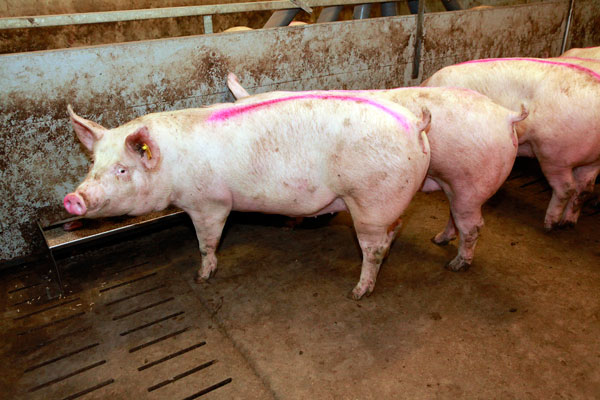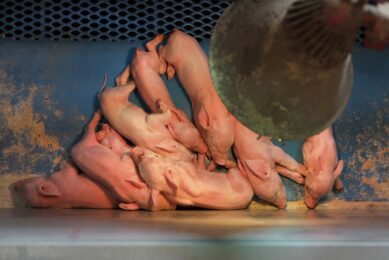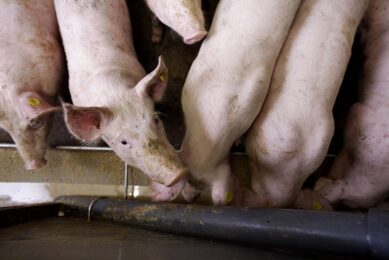More sustainability leads to higher pig profits

Profitability in swine production depends on optimising lifetime output per sow breeding place. But often potential sow lifetime is cut short through early culling because of breeding problems, or leg and feet faults.
By: DSM
In this way, sows often leave the herd before they can earn any sort of return. Prolonging sow production lifetime remains an important goal nowadays while success has already been achieved in other fields with more reproductive efficiency, bigger litters, improved growth rate, feed conversion and particularly – carcass lean meat percentage.
The key to higher sustainability: longer productive life with resultant more pigs reared and higher earnings per sow is ensuring a high nutritional standard including the right supplementation. Vitamin D, for instance is very important. When added pure as a supplement, this is metabolised is to vitamin D3 or calcifediol. It contributes towards building and sustaining strength in sow skeletal framework.
Ever-higher housing and feed costs mean there no ‘break-even’ on investment per sow and sow place until after the third parity for farrow-to-finish enterprises, or even after the fourth litter where weaner production is the business (Figure 1). The reasons given in herd records for such early culling usually start with breeding difficulties, followed by lameness or feet and leg problems. In fact, research shows that the last-mentioned are much more important than the records indicate.
After all, missed oestrus, failure to conceive or poor litter nursing performances given as reasons for culling are often primarily because of leg and feet problems. A lame sow in the farrowing pen does not want to stand and eat, for instance. The result: She loses body condition during suckling. Not only does litter growth suffer, but the sow also can lose so much condition that getting her back into pig after weaning can be difficult.
Poor skeletal structure and nutrition
Poor skeletal structure is an important factor in such feet and leg problems and proper development here relies to a great extent on sow nutrition. Crucial in bone development is, of course, calcium and phosphorus – but also vitamin D3. This vitamin is responsible for calcium and phosphorus homeostasis. However, sometimes it fails to achieve a fully function form which can then limit bone strength and mineralisation (Figure 2).What happens is that vitamin D3 is synthesised in the liver to form 25-OH D3 and then in the kidneys to 1.25 OH D3. It is the first step in the natural metabolism of vitamin D to D3 that can fail. This involves hydroxylation of vitamin D to 25-0H D3 in the liver.
To solve this problem, DSM Nutritional Products produces a straight 25-OH D3 commercially under the trade name Rovimix Hy-D 1.25%. Firstly, Hy-D is a label much easier to remember than ’25-hydroxycholecalciferol’. But more importantly, the product is less water-repellent, thus more easily and much more efficiently absorbed from the gut.
Being hydroxylated, the product is also already a step ahead in vitamin D3 metabolism, bypassing the liver stage and quickly and very efficiently reaching the blood stream. A single gram of Rovimix Hy-D 1.25% replaces 500 IU vitamin D3 in feed (1 IU of vitamin D3 being equivalent to 0.025 μg 25-hydroxycholecalciferol).
Stronger bones is key
Sows fed Hy-D, compared with those receiving equivalent doses of standard vitamin D3, prove to have significantly higher plasma levels of 25-OH D3. The result is better mineral absorption and stronger bones within an overall better skeletal structure (Figure 3). To better understand the role of vitamin D3, or rather of its functional metabolite calcifediol that acts like a normal hormone; let’s take an example of a lactating sow that cannot consume enough feed to meet her calcium requirements. This is a common state of affairs with most modern hyperprolific lines. The resultant insufficient calcium intake could, with the required high milk production, mean blood levels of the mineral dropping below the danger point leading to tetany (milk fever), coma and eventually death. Normally, nature steps-in before this by drawing on calcium reserves in the bones to help restore blood calcium levels.
Here, calcifediol is closely involved in ensuring that the sow has enough minerals in her blood to meet requirements. This is especially important during early lactation when feed intake tends to be depressed. But prolonged mobilisation of minerals in this way attacks skeletal structure. The results include overall performance drops and reductions in sow productive lifetime.
Longevity and sustainability
The cost-efficient solution for sustainable benefits in modern pig production is feeding sows Rovimix Hy-D 1.25%, the supplement containing 25 OH D3 (calcifediol). The benefits are sustainable because, first of all, the selection rate of gilts is improved, particularly where this is based on frame development parameters. Several studies have shown that the proportion of gilts selectable for herd replacement is increased. For example, in a German trial run in cooperation with a swine breeding company, Hy-D supplementation improved gilt selection rate by 7% (Figure 4) through improved skeletal frames and therefore stronger legs.
Last but not least, continuous supplementation Hy-D in sow rations throughout their successive reproductive cycles has the potential of significantly reducing numbers of culled sows, and therefore replacement gilt requirements, through helping to ensure stronger bones and preventing leg disorders. A recent 250-sow German trial (Figure 5) over two successive parities showed how calcifediol supplementation increased sow and litter performances in this respect. The Hy-D supplemented sows produced less dead-born piglets at farrowing with culled sow numbers also less than control.
Subsequent research showed that bone mineral density was higher with the Hy-D-fed sows, and litter growth performance better than control sows with diets supplemented with standard vitamin D3.
Example
To spell-out these benefits, let’s take the example of a farmer with 1,000 sows producing own replacement gilts and supplementing sow fed with calcifediol instead of standard vitamin D3. Trial results indicate that it’s realistic to assume gilt selection rate could consequently be improved by 7% and replacement rate by 5% through the Hy-D effect on bone health. This would mean 124 fewer gilts would need to be kept as replacements. The benefits for the production unit will not only turn into a better return on investment (€3 gain minimum for €1 invested leading to an additional revenue of €8 per sow) but also into significant savings: less feed, lower water use, a reduction in manure generated and nitrogen excreted (Figure 6).
The bottom line here is that increasing calcium and phosphorus homeostasis and bone mineralisation through Hy-D supplementation improves breeding sow sustainability and profitability.
Trials prove that feeding this specific vitamin D metabolite achieves longer lifetime production performance. And the results clearly indicate other benefits also very important nowadays: Those of improved animal welfare and environmental protection.
 Beheer
Beheer








 WP Admin
WP Admin  Bewerk bericht
Bewerk bericht